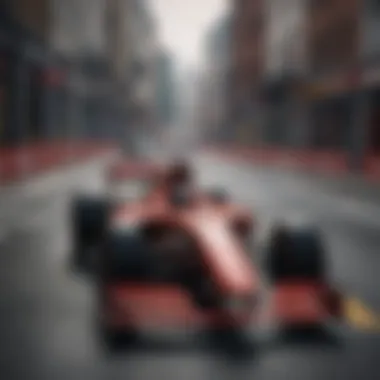Exploring the Thrill of F1 Ride Along Experiences


Intro
The world of Formula 1 racing represents not just speed, but a rich tapestry of skill, technology, and passion. Among the various experiences available to motorsport enthusiasts, F1 ride along experiences stand out as both exhilarating and educational. These experiences grant participants the opportunity to feel the raw power of an F1 car while gaining insights into the sport's intricacies.
Ride alongs strip away the barriers between spectators and the action, allowing for a firsthand dive into the high-speed world of F1 racing. This article aims to explore the dynamics of these unique experiences, such as technical aspects, preparation needed by participants, and the adrenaline rush involved. It serves as a comprehensive guide not only to those eager thrill-seekers but also to aspiring drivers keen to understand the underlying elements of motorsport.
Let's begin by examining some techniques and tips, which can help improve the ride along experience.
Understanding the Concept of F1 Ride Along
The concept of Formula 1 ride along experiences has gained significant traction among motorsport enthusiasts. This section aims to unveil the nuances of these unique experiences, which allow participants to feel the raw power and speed of a Formula 1 car while being driven by professional drivers. Understanding this concept is essential for anyone interested in the thrill of racing or considering participation in these experiences. It covers several key elements, such as the mechanics behind these rides, safety considerations, and the overall benefits to the participants.
Historical Context of Ride Along Experiences
The ride along experience is not a recent invention in motorsport; its roots can be traced back to the early days of racing, when enthusiasts were taken for rides in powerful cars. Initially, these experiences were informal, often conducted by local racers or during exhibition events. However, as Formula 1 began to cement its position as a global phenomenon, organized ride along programs emerged as a formal offering, allowing fans and thrill-seekers to taste the high-speed lifestyle of professional racing.
The introduction of these experiences coincided with the growth of motorsport technology and safety protocols. Manufacturers realized that providing ride alongs could enhance the fan experience and branch out their audience reach. The historical perspective emphasizes how the initial idea transformed into a comprehensive experience that combines excitement, safety, and education for participants and spectators alike.
Defining the F1 Ride Along Experience
The F1 ride along experience is characterized by a few distinct features that set it apart from other motorsport activities. Essentially, it involves a passenger, typically in the passenger seat of a Formula 1 car, traveling at high speeds around a race track under the guidance of a seasoned driver. This setup allows participants to witness firsthand the capabilities of the car and the expertise of the driver.
Several aspects define this ride along experience:
- Speed and Power: Being within an F1 car, known for its engineering excellence, showcases the sheer speed and power that these machines possess. This aspect alone is a significant motivator for many participants.
- Professional Drivers: The experience typically features highly skilled, professional drivers. These individuals are trained to handle the demanding nature of F1 driving and ensure the safety of passengers throughout the ride.
- Track Layout: Each ride is conducted on a specific track layout, allowing participants to experience the nuances of racing in a controlled environment.
- Safety Measures: Safety is of utmost importance in these experiences. Participants are briefed thoroughly about the safety protocols before taking the ride. This includes proper harnessing techniques and the expected behavior during the ride.
- Educational Component: Many ride along programs incorporate a brief educational component, often explaining the dynamics of F1 racing, car mechanics, and the physical challenges that come with driving at such high speeds. This is not merely a thrill experience; it provides insights into the world of professional motorsport.
"A ride along in an F1 car is not just about speed; it encompasses a comprehensive understanding of what drives the excitement of motorsport."
In summary, the F1 ride along experience is an unparalleled opportunity that bridges the gap between fans and the exhilarating world of Formula 1 racing. Through this journey, participants get to engage with the sport on a deeper level, gaining firsthand knowledge while enjoying the adrenaline rush that accompanies speed.
The Mechanics of Formula Racing
Understanding the mechanics of Formula 1 racing is essential to truly appreciate the F1 ride along experience. This section not only highlights the complexities and technologies behind these high-performance vehicles, but also emphasizes the importance of safety protocols and the intricacies that contribute to the overall experience. Knowledge of vehicle dynamics and safety features enhances both the excitement and the expectation of participants. This understanding aids in setting realistic perspectives on what the ride will entail and ensures that participants appreciate the full spectrum of the experience.
Understanding F1 Vehicle Dynamics
F1 vehicles are masterpieces of engineering. Each component is optimized for performance. The light yet strong materials used in construction such as carbon fiber seriously influence vehicle dynamics. These cars can reach speeds of over 200 miles per hour. At these velocities, even the smallest factors, like weight distribution and aerodynamics, play a pivotal role in how the car behaves on the track.
When a ride along participant experiences a lap in one of these cars, they will notice the unique handling characteristics. The responsiveness to steering inputs is sharp, and the high grip levels ensure that the car adheres to the track. Understanding these dynamics informs participants how and why they will experience extreme acceleration and cornering forces during the ride. Realizing how the vehicle's systems work helps participants appreciate the skill of the driver and enhances the thrill of the experience.
Safety Features and Protocols
Safety in Formula 1 is non-negotiable. The design and engineering of F1 vehicles incorporate several advanced safety features which ensure the well-being of both the driver and the passenger during ride along experiences.
Some key safety features include:


- Halo Device: A structure that protects a driver's head in case of an accident.
- Strong Cockpit Structure: Designed to withstand extreme pressure and impacts.
- Advanced Fire Retardation Materials: These materials minimize injury risk in fire scenarios.
- Harness Systems: Properly designed harness systems secure the passenger in place, essential for high-speed maneuvers.
Pre-ride briefings are a critical part of the protocol. Participants are informed about what to expect, safety procedures, and how to remain safe during the ride. This preparation ensures that every individual involved is aware of their surroundings and procedures in case of an emergency.
"Safety in Formula 1 is a cultural priority, dictating every aspect from design to execution."
By understanding these safety measures, participants can fully engage in the exhilarating experience while knowing they are in a controlled environment. The depth of safety knowledge enhances confidence and ultimately contributes to a richer overall experience.
Preparation for an F1 Ride Along
Preparation for an F1 ride along is a vital phase that shapes the overall experience for participants. It encompasses both physical and mental readiness, which lays the foundation for how one will react to the high-speed environment of a Formula 1 car. This section delves into the specific elements necessary for a successful ride along, highlighting the benefits and considerations that should not be overlooked.
Physical and Mental Readiness
Physical and mental readiness is essential for anyone embarking on an F1 ride along. The sheer speed and G-forces involved in this experience can be overwhelming. Thus, participants should be aware of their fitness levels and any pre-existing conditions that might affect their comfort and safety.
- Fitness Level: Individuals should engage in moderate physical activity leading up to the experience. Core strength and cardiovascular health play a significant role in withstanding the forces encountered in a high-speed ride. Simple exercises that focus on core stability and endurance can be beneficial.
- Mental Preparedness: Equally important is the mental aspect. It's crucial for participants to approach the ride with a clear mind. Building confidence through visualization techniques can help in this regard. Imagining the ride and anticipating the sensations can make the experience less daunting.
- Breathing Techniques: Learning how to control breathing can be invaluable. Anxiety may arise during the ride, so practicing deep breathing can help in managing adrenaline surges, ensuring the experience is enjoyable rather than overwhelming.
In summary, physical fitness and mental clarity collectively enhance the ability to fully embrace the ride along experience.
Understanding the Briefing Sessions
Prior to the F1 ride along, participants typically partake in a briefing session. This is not merely a procedural formality; it serves to equip riders with critical information and prepare them for what to expect.
- Safety Protocols: The guiding principles of safety are reviewed thoroughly. Key procedures, like how to communicate with the driver and what to do in the event of an emergency, are discussed. Familiarity with safety equipment, such as helmets and harnesses, is also imparted.
- Vehicle Dynamics: Briefings often cover vehicle dynamics and how basic operations work, including how acceleration, braking, and cornering feel at high speeds. This knowledge can aid in reducing apprehension and fostering a better understanding of the ride.
- Expectations Management: Clarity regarding what participants can expect helps set realistic expectations. Understanding the role of G-forces and how they will affect the body allows participants to comprehend the sensations they will experience, making it easier to embrace them.
Incorporating these elements into preparation not only enhances safety but enriches the overall experience.
Ultimately, preparation for an F1 ride along can significantly determine the fulfillment and excitement derived from such heart-pounding adventures.
Experiencing the Adrenaline Rush
Experiencing the adrenaline rush in a Formula 1 ride along is a pivotal aspect of the whole experience. This thrill stems not only from the high-speed context of the ride but also from the unique psychological and physical sensations that participants encounter. Understanding these factors can significantly enhance one's preparation and overall enjoyment of an F1 ride along.
The Role of G-Forces in F1
The G-forces felt during an F1 ride along are intense and can be surprising for many participants. G-forces, or gravitational forces, measure the acceleration that impacts a driver during high-speed maneuvers. During sharp turns, high speeds, and sudden stops, participants may experience forces of up to 3 to 5 Gs. This means that they will feel three to five times heavier than their normal body weight.
These forces act on the body in ways that are often unfamiliar. For instance, during a left turn, the body pushes against the right side of the car, and the feeling of weight shifts dramatically.
To prepare for these sensations, participants should be aware of how their body might react. Some might find the heightened feeling exhilarating, while others could experience discomfort. Regardless, awareness can help participants embrace the experience fully.
"The thrill of F1 racing lies in the physical sensations that only a few can truly understand until they experience them firsthand."
Mental and Emotional Reactions
Alongside the physical sensations, mental and emotional reactions also play a crucial role in the overall experience. When participants step into the car, there is often a mixture of excitement, fear, and anticipation. The rapid changes in speed and direction, coupled with the roaring engine noise and the rush of air, can trigger a variety of emotional responses.


For many, this mix can lead to a heightened sense of awareness and engagement with the experience. Some may find their heart racing, while others may feel a sense of calmness overcoming them as they surrender to the speed. It's also common to feel a deep satisfaction once the ride concludes, as participants reflect on the uniqueness of the experience.
To better process these emotions, participants can employ various strategies, such as deep breathing techniques and positive visualization prior to the ride. Understanding that these feelings are natural can also help to enhance enjoyment.
Technical Insights into the Ride
Understanding the technical insights into the ride is essential for grasping the complete F1 ride along experience. This segment provides participants not just a thrill, but also an education on the advanced mechanics and strategies that underpin Formula 1 racing. Gaining knowledge about these elements enhances appreciation for both the sport and the technology involved.
Understanding Pit Stops and Strategies
Pit stops are crucial in Formula 1. They can determine race outcomes. In a ride along, participants witness firsthand the precision and speed involved in these stops. During a typical pit stop, teams perform tire changes, fueling, and make adjustments, all in a matter of seconds. The strategy surrounding these operations is equally critical. Factors such as tire wear, fuel load, and track conditions dictate when a pit stop is most advantageous.
For ride along participants, understanding these strategies can transform their experience:
- Timing is everything: Knowing when to pit can mean the difference between winning and losing.
- Crew Coordination: Each member of the pit crew plays a specific role, and their synchronization is vital for efficiency.
- Tires: Different types of tires are used for different conditions, impacting speed and grip.
"Effective pit stop strategy can gain or lose several seconds, which in racing is monumental."
Data Acquisition and Telemetry
Data acquisition in F1 involves collecting real-time information from various car systems. This data is critical for ensuring optimal performance. Telemetry allows teams to analyze the car's behavior under different conditions. For participants, exposure to this technology during a ride can add a layer of understanding to the experience.
Key aspects of data acquisition and telemetry include:
- Speed Monitoring: Real-time tracking of the car's speed helps in making quick decisions.
- Engine Performance: Information about engine outputs and efficiency is vital.
- Tire Performance: Data regarding tire temperatures and wear informs strategy.
By exploring telemetry, ride along participants can appreciate how data influences decisions made during a race, highlighting the intricate relationship between technology and performance.
Both pit stops and telemetry reflect the complexity and precision of Formula 1 racing. Understanding these aspects not only enhances the ride along experience but also fosters a deeper connection to the sport itself.
Post-Ride Reflections
Post-ride reflections are an essential component of the F1 experience. After the thrill of being in a high-speed ride, participants need to process what they have just experienced. This section is dedicated to understanding the significant elements that follow a ride along and how they contribute to personal growth, safety understanding, and overall enjoyment.
Analyzing Performance and Feedback
After each ride, participants often evaluate their performance, even if they are not the primary drivers. This process can involve reviewing data shared by the driver or team, such as speed, braking patterns, and cornering techniques. Feedback can be crucial in several ways:
- Skill Improvement: Understanding what occurred during the ride can lead to better techniques for aspiring drivers.
- Safety Awareness: Participants also learn about the importance of safety measures taken by the professional drivers and teams.
- Adaptive Learning: Each ride can reveal how responses to speed and maneuvering could be improved in future rides or overall driving skills.
The exchange of feedback between the driver and participant often fosters a deeper understanding of the complexities involved in professional racing. Participants can ask questions about the specific maneuvers and decisions made, enhancing their appreciation of the sport.
Emotional Processing of the Experience
The emotional response to an F1 ride along is powerful and can vary widely among participants. Initially, feelings of excitement and exhilaration are common. However, as participants reflect, they may encounter a range of emotions:


- Elation: Coming off the high-speed lap, many feel a rush of joy and satisfaction.
- Anxiety or Fear: Some may confront the realism of speed and danger, leading to heightened anxiety about their experiences.
- Calmness and Reflection: Over time, participants could achieve a state of calm as they reflect on what the ride meant for them personally.
"The emotional journey after an F1 ride is often just as intense as the ride itself, serving as a powerful reminder of one's limits and aspirations."
Engaging in discussions with fellow participants or enthusiasts can help in processing these emotions. Sharing experiences fosters a community feeling and encourages reflective thinking about the role of motorsport in personal adventure.
Concluding, post-ride reflections are crucial for both immediate enjoyment and long-term engagement with the world of motorsports. Understanding performance and analyzing emotions provide valuable insights into the overall experience of F1 ride alongs.
The Broader Impact of F1 Ride Alongs
The influence of F1 ride along experiences extends beyond personal thrill. They have far-reaching implications for both the individual participants and the motorsport industry as a whole. Understanding these impacts reveals how these experiences foster a deeper appreciation for racing and contribute to the educational fabric of motorsports. It’s essential to consider the elements such as educational benefits, community connections, and the broader cultural impact of these experiences.
Educational Value for Aspiring Drivers
F1 ride alongs serve as an invaluable learning platform. They provide aspiring drivers with a real-world glimpse into the complexities of high-performance racing. Being a passenger in a Formula 1 car allows participants to observe firsthand the car's capabilities, performance dynamics, and the skills required to control such powerful machinery at breathtaking speeds.
- Skill Acquisition: Participants notice how drivers handle sharp turns and respond to unexpected challenges, imparting critical insights into racing techniques.
- Real-Time Feedback: Many programs include debrief sessions where experienced drivers share tips on improving driving styles and decision-making in competitive environments.
- Understanding Vehicle Technology: Participants gain knowledge about the intricate technology that powers F1 cars, such as aerodynamics and tire management.
This immersive educational value enhances the participant’s comprehension of racing, potentially influencing their future career paths in motorsports.
Connection to the Motorsports Community
F1 ride along experiences are more than just opportunities for excitement; they cultivate a sense of belonging within the motorsports community. Engaging with the sport on this level allows participants to connect with like-minded individuals who share a passion for racing.
- Networking Opportunities: Participants often meet industry professionals, team members, and fellow enthusiasts, expanding their networks and opportunities.
- Community Building: These experiences promote the sharing of stories and knowledge among fans, thus fostering a supportive community. Participants often connect through social media platforms, such as Facebook and Reddit, where they exchange tips or discuss their rides.
- Increased Engagement with the Sport: By experiencing the thrill of F1, participants are likely to become more invested fans. This increased affiliation can lead to higher attendance at races and broader support for motorsport events.
Future Trends in F1 Ride Along Experiences
The landscape of Formula 1 ride along experiences is evolving rapidly. With the continuous advancement of technology, these experiences are becoming more dynamic and engaging. Understanding these trends is vital for participants, organizers, and enthusiasts alike. The future holds promise for not just enhanced experiences but also greater safety and accessibility.
Technological Advancements
Technology plays a crucial role in transforming F1 ride alongs. Enhanced simulation techniques are paving the way for more immersive experiences. Virtual reality (VR) and augmented reality (AR) offer ways to simulate high-speed racing without the associated risks. These technologies enable participants to feel the thrill of racing before getting behind the wheel.
Performance data analysis is also becoming more integrated. Advanced telemetry systems allow ride along participants to gain insights into the vehicle's mechanics during the experience. This data can be analyzed to understand vehicle dynamics better, improving future rounds.
Moreover, innovations in car design contribute to ride along safety. Improved safety protocols and vehicle construction mean that participants can enjoy these experiences with added peace of mind.
In the racing industry, electric vehicles are gaining traction. It is not far-fetched to envision electric F1 cars offering ride alongs in the future. This would not only widen the appeal among new enthusiasts but also contribute to the sustainability efforts within motorsports.
Increased Accessibility for Participants
Accessibility is a significant trend influencing F1 ride along experiences. As the motorsport community aims to democratize thrill-seeking experiences, more opportunities are opening up. Previously, these rides were predominantly available to a select group of individuals with ample resources. Now, organizations are launching programs aimed at making these experiences attainable for a broader audience.
Some key factors driving this increase in accessibility include:
- Partnerships with organizations: Collaborations with corporate sponsors help subsidize costs, making rides more affordable.
- Diverse offerings: Many experiences cater to various skill levels. They range from those who want a gentle thrill to extreme high-speed experiences. This variety invites more people to participate.
- Location expansion: Ride along sessions are available at a growing number of circuits around the world. This makes it easier for enthusiasts to find an experience near them.
Another notable aspect of increased accessibility is the introduction of educational programs tied to these experiences. Aspiring drivers or enthusiasts can combine learning with the experience, enriching their understanding of F1.
"The evolution of F1 ride along experiences not only caters to thrill-seekers but also nurtures the next generation of motorsport enthusiasts."
In summary, the future trends in F1 ride along experiences reflect a blend of innovation and inclusivity. Technological advancements focus on enhancing the experience, while increasing accessibility ensures that more people can enjoy the thrill of racing. This combination is set to shape the next generation of motorsport participation.







